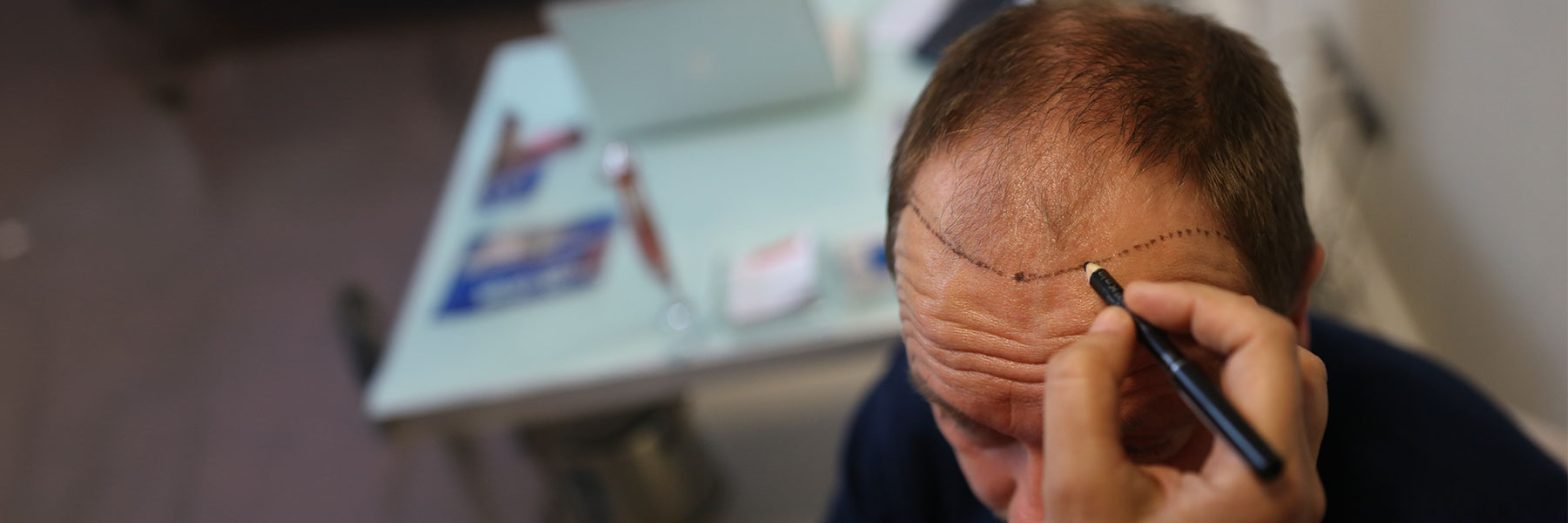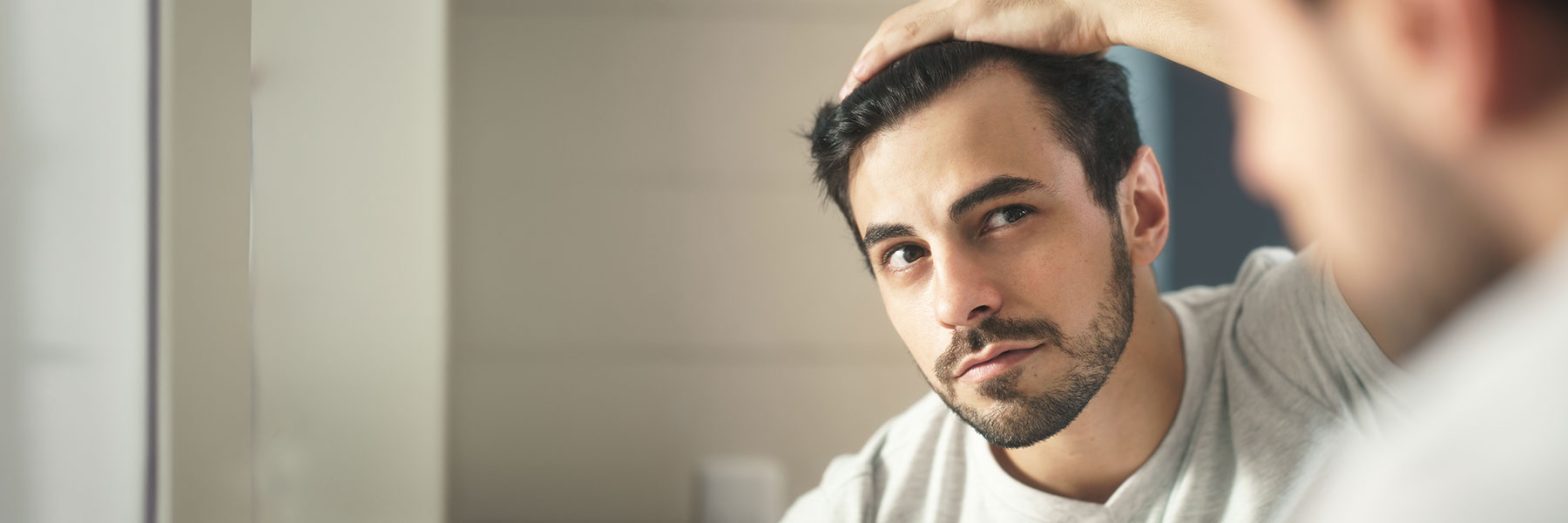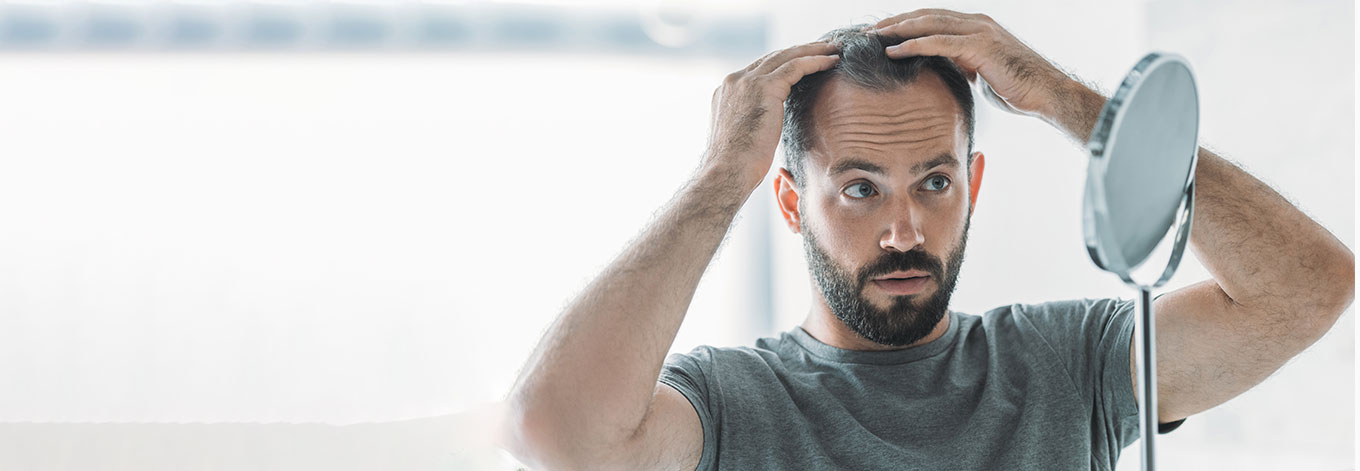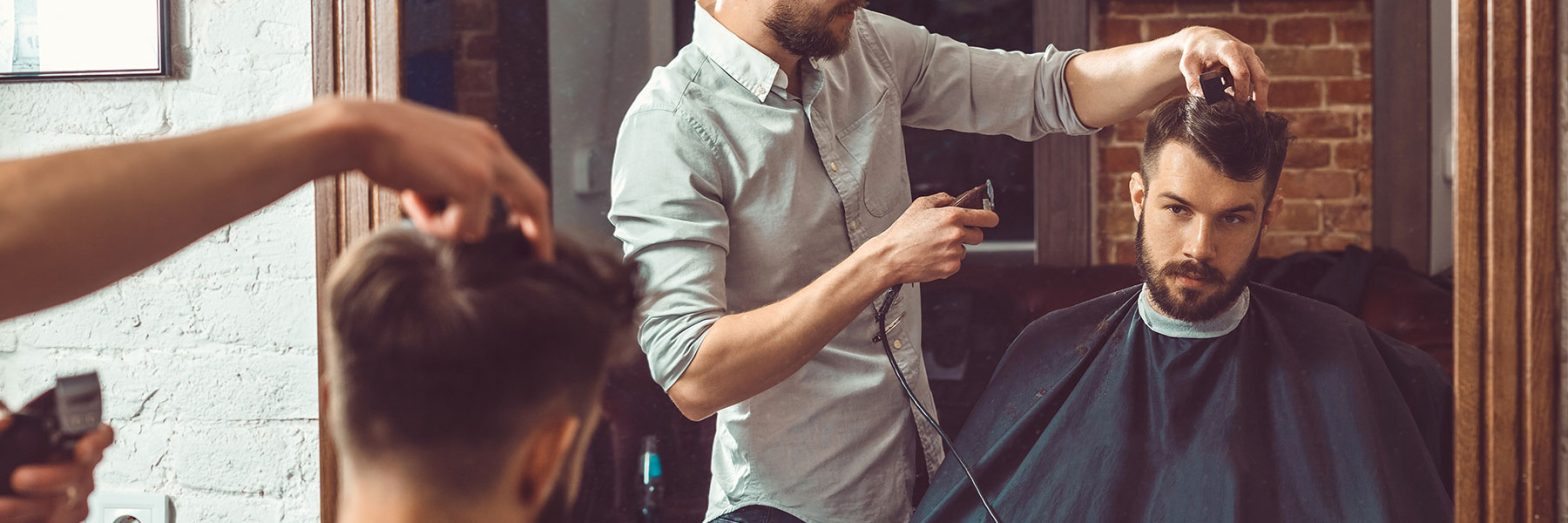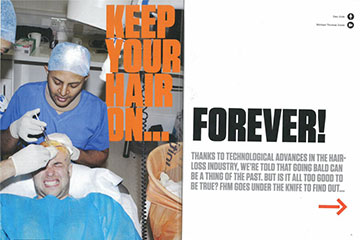
Keep your hair on…FOREVER!
HAIR LOSS & HAIR TRANSPLANTS
FHM Magazine
It’s 10:30 on a Wednesday morning and I’m watching Jeremy Kyle with my feet up.
Behind me stand two men draped in green doctor’s gowns and masks. One of them holds what appears to be a dildo wrapped in a surgical glove; the other, a 4-inch needle. They step towards me and stare into my terrified eyes. They tell me it won’t hurt, that I won’t feel a thing. I shut my eyes. It’s about to begin.
I’m in The Private Clinic, on London’s prestigious Harley Street: the go-to hair transplant destination for the rich and famous. Today, it’s not Wayne Rooney or Gordon Ramsay under the knife. It’s me: a balding, 29-year-old journalist.
The man holding the needle is Dr Raghu Reddy, the country’s leading hair transplant surgeon. (In case you were wondering, his assistant’s gloved vibrator is to innocently massage my scalp, diverting the pain away from the anaesthetic injection.) Although you don’t have to be famous to be treated at The Private Clinic, you do need to be rich (or at least a lucky, all-expenses-covered journalist). The hair transplant procedure I’m about to undergo takes 20 hours, and costs £2.50 per hair – in my case, around £20,000 for 8000 follicles. That’s a grand an hour – no small change – though when you consider that a recent study found that nine out of 10 balding men cite baldness as the number one source of anxiety and distress in their life, perhaps it’s understandable why business is booming for the hair-loss industry.
Rewind a few years and you couldn’t have paid me £20,000 to have a hair transplant. Just saying the words conjured up images of some poor bastard with pubes glued across a cue ball scalp.
But times are changing, and advances in new surgical procedures have boosted an already lucrative industry. This year, more than 100,000 procedures will be performed worldwide, around 5% being in the UK. More importantly perhaps, hair transplants performed by leading technicicans are now so successful that in tests performed last year, the majority of people couldn’t even identify transplantees in a line-up. The claims are big and the numbers are impressive – as is the safety record (it’s all done under local anaesthetic, so the procedure is virtually zero-risk). But as the first needle pierces my freshly shaven scalp, the stats evaporate and I’m overwhelmed by a tsunami of emotions. Fear (what if they botch my transplant?) Anxiety (will the procedure hurt?) But mostly, a sense of hope that soon, I might be free from something that’s burdened my life for the past 10 years, deeply affecting my confidence and sense of identity.
I know that balding is not some terrible disease. It doesn’t make you sick. Some guys lose their hair and aren’t remotely bothered. But research shows that the vast majority of men who go bald prematurely suffer from profound psychological effects, and I’m no different.
While the have-hairs can laugh off going bald as no big deal – putting it down to a midly unfortunate but largely insignificant defect – most young blokes who’ve felt the chill of a cool breeze against their cranium are all too aware of the self-esteem-sapping power of the premature balding gene.
Waking up in my university bed the day after my 19th birthday with a pounding hangover, I noticed that I had company in the form of several black hairs on my pillow. At first, I shrugged it off. Maybe it was my student diet of value baked beans and Jägerbombs taking its toll? But over the weeks that followed, I started to notice hairs swirling around the plughole in the shower, or leading themselves on my fingertips when I scratched my head. As I surveyed my hairline in the mirror, it suddenly hit me: I’ve just turned 19 and I’m going bad.
When you’re still a teenager and your hair begins to shed, you feel a lot of things, but mostly you feel intensely alone.
In actual fact, I wasn’t. A quarter of men experience the first signs of hair loss before their 21st birthday. But when you’ve always had thick, curly locks and you’re forced to contemplate spending the rest of your life without any, it’s an extremely solitary place to find yourself.
We live in a society where the handsome, the rich and the powerful have hair. In film and TV, parts for baldies are generally reserved for evil villains or fearless hard men – try to think of the last romcom you saw with a hairless leading male. This all drops down to your subconscious and when your hair vanishes, the first thing to accompany is self-confidence. I’d always been self-assured and comfortable in my own skin – even a tad vain, like most 19 year olds. But within months of becoming folically challenged, my life changed. Previously, I’d never had a problem chatting up girls on a night out, but I’d find myself unable to pluck up the courage to make a move, terrified that I’d catch a pretty girl sneaking a peek at my receding hairline. Even though it was barely noticeable, in my head I stuck out like a prematurely ageing sore thumb.
You know deep down that it shouldn’t really matter. That you’re still the same person. But it does matter. Going bald is a deeply personal phenomenon, and even though others were oblivious to my receding hairline, I become increasingly obsessed as my 20s wore on. A day wouldn’t pass without dwelling on it. I’d cup my hands around my face and imagine how hideous I’d look with nothing on top. Every bloke I passed on the street became someone to compare myself with – the sight of a stranger with a thick head of hair would cause me to swell with envy.
I became a pro in the art of concealment. In winter, I’d wear beanies at any given opportunity; in summer, I’d cut my hair shorter and shorter, hoping to obscure my increasingly hairless pate. But hiding baldness is like trying to conceal a massive zit. You can wear your girlfriend’s make-up all you like but eventually, people are going to notice. And even if they don’t, you notice.
What do Matthew McConaughey, Bradley Cooper, Louis Walsh, James Nesbitt, Gary Lineker and Declan Donnelly have in common?
If the internet is to be believed, they’ve all had hair transplants. Some have admitted it, others haven’t. And it’s not just actors and TV personalities who’ve gone under the knife to prevent thinning hair either; a number of sportsmen, past and present, have spoken out publicly about their transplants.
Among the first to bring awareness to the masses were Shane Warne and Michael Vaughan, the cricketers who fronted a TV ad campaign for a popular hair-loss solution at a well-known clinic. It was this ad which, around five years ago, prompted me to book an appointment with the local London clinic (I’d love to name and shame them but the lawyers won’t let me). My visit was a total disaster: after someone baffled me with talk of lasers and showed me some ludicrous price tags, I left feeling more confused, frustrated and hopeless than before.
The following week, I visited another ‘specialist’ in the industry. After a brief consultation, I was told that hair loss could be prevented by their special lotion, which I had to apply twice a day. “Why the hell not?”, I thought. So I handed over several hundred pounds and was t old to come back in three months.
Three months passed. Then another three. And before I knew it, I was a year down the line, £2,000 poorer, and balder than when I’d started. After trawling hair-loss forums online, it became apparent that I was by no means alone. Men the country over had spunked huge sums on ‘miracle cures’ which, like mine, had turned out to be junk, dolled out by snake-oil ‘doctors’ preying on those so desperate for a cure, they’d pay anything.
It wasn’t until I saw a Twitter post last summer that I started to believe that my fantasy of having a full head of hair could become reality. As an Arsenal fan, I don’t usually care much for what Wayne Rooney has to say, but when he tweeted, “Just to confirm to all my followers I have had a hair transplant. I was going bald at 25. Why not?”, something clicked. If Wazza could do it, why couldn’t I?
After spending weeks reading up recommendations and condemnations online, my search led me to Dr Reddy who, from what I could discern is to hair transplants what Stephen Hawking is to physics: a pioneer who has taken the techniques for the procedure – and the results – to the next level.
The vast majority of hair transplant surgeons employ a technique called Strip Surgery, whereby a strip of skin containing hair follicles up to 1cm deep and 30cm wide is removed from the back of the head before the hairs are taken out of the skin and replanted where needed. While it has achieved some strong results, it leaves a permanent scar across the back of the head, and has a lengthy recovery period. It can also be very hit and miss.
Dr Reddy, along with only a handful of other surgeons around the world, performs a procedure called Follicular Unit Extraction (FUE). Individual hairs are removed from the donor area (the back of the head where we have so many hairs that no one will ever notice they are missing) before being reinserted one by one across the front of the crown. The procedure takes longer and is more challenging, but I’m told it produces industry-leading results and leaves no permanent scarring.
Since 2007, Dr Reddy has seen men of all ages, from 17 to 70. He’s treated footballers and actors, plumbers and journalists. Some 15,000 men have passed through his doors in search of his elixir of youth, though under 20% of those he consults actually qualify for the treatment – sadly, once you’re too far gone, reversal isn’t possible. I’m just the right level of bald – enough gone to achieve results; enough left to take from the hair-rich areas and give to the poor.
And so it is that I find myself being massaged by a gloved dildo, as Dr Reddy begins to remove my healthy hairs, one by one, passing them to an assistant who readies them for reinsertion. The procedure is uncomfortable but not unbearable. Barring sporadic moments of mild pain, it’s mostly just boring – 20 hours of daytime telly is enough to rot anyone’s brain. It’s certainly not for the faint of heart or those who an aversion to blood – there’s a lot of it, and throughout the procedure you look like Hellraiser – but considering that you’re having thousands of incisions made to your head, it’s nowhere near as bad as you’d imagine.
At the time of writing, it’s been six weeks since the procedure.
The recovery period is minimal – the scabs fall off after a week and new hair starts to come through immediately. Although it takes between nine and 12 months for full regrowth, I’m already beyond chuffed with the results – just touching the new, thick hair across the front of my scalp brings a smile to my face.
Since the op, I’ve been asked by a lot of people if I’m embarrassed to admit that I’ve had a transplant, or if I think there’s a stigma around men undergoing cosmetic surgery. The truth is I that I don’t feel any shame – as soon as I got home from the clinic, the first thing I did was put up a #posttransplantselfie on Facebook (which, incidentally, fast became my most popular post ever, racking up over 100 ‘likes’ and positive comments within an hour.)
It may still not be considered ‘masculine’ to care about the way you look, but times are changing. Ten years ago, blokes didn’t wear moisturiser. Now there are almost as many grooming products on sale for men as there are for women. Every single guy I’ve spoken to since having the transplant has said that if he were going bald and could afford to do something about it, he would. At present, the shortage of top-class technicians, coupled with the eye-watering price tags means that for many, hair transplants are a thing of the future, not the present. That won’t be the case for long.
As more celebs and sportsmen parade their successful results, guys will realise that transplants aren’t the ‘cut-and-stick’ procedures they once were. Instead, they are life-changing, confidence-boosting escape routes from a life less hairy – and, as I’ve found out, that’s something you can’t easily put a price tag on.





